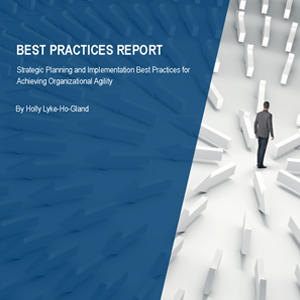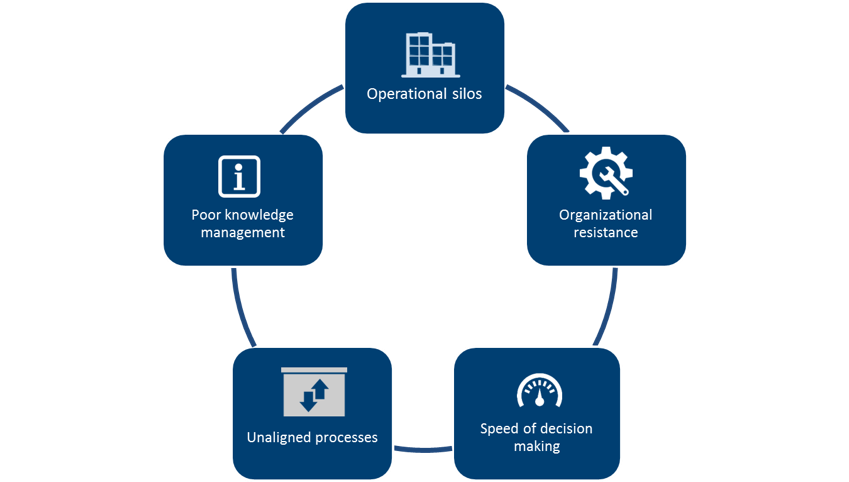
What's Slowing Down your Organization's Agility?
By Holly Lyke-Ho-Gland, APQC
Organizational agility is the ability to quickly identify (strategic responsiveness) and execute initiatives (organizational flexibility) to respond to opportunities and risks that align with the overall strategy. Organizations have to keep pace with the opportunities and threats created by growing customer demands and disruptive changes such as big data and the internet of things. This means that organizations must not only track changes in their business environments but also nimbly change direction and implement new initiatives in order to avoid risks or achieve competitive advantages.
In February 2016, APQC and its research partner Strategic and Competitive Intelligence Professionals (SCIP) conducted a survey to gauge organizations’ agility and understand what strategic planning practices drives agility. In addition to questions about strategic planning practices, the survey also asked respondents to indicate their top obstacles to achieving agility (Figure 1). To download this feature report, please visit: https://www.apqc.org/knowledge-base/documents/strategic-planning-and-implementation-best-practices-achieving-organization.
Top Five Obstacles to Agility
OPERATIONAL SILOS
With operational silos, employees are driven to meet personal or team objectives without knowing or understanding what similar or related initiatives are running in parallel around the organization. This ultimately results in missed opportunities to improve efficiency and the need for additional communication and change management efforts for new initiatives.
How to Address the Obstacle
There are many sources of operational silos. However, the most common sources include functional-focused thinking and unaligned or conflicting measures.
It’s easy to understand why most organizations rely on functional thinking. It provides a specialized competency, and performance measurement is relatively easy. But there are limitations to functional thinking. Primarily, it doesn’t include the complete value chain, which:
- Makes it easy to lose sight of the impact on the customer,
- Increases the difficulty of implementing or improving processes, and
- Results in siloes and placing blame when things go wrong.
On the other hand process, process thinking involves focusing on the value chain and conceptualizing groups of activities as processes. Such thinking reveals how all of the processes and groups work together to take inputs and produce products, services, and profits. More advantages of process thinking include the ability to align measure across functions and focus measures on the long-term goals of the business.
ORGANIZATIONAL RESISTANCE
There is the common adage that if there is no resistance, it's likely that no significant change has taken place. However, organizational resistance that's too strong or widespread impedes organizations' ability to execute quickly and implement or adjust processes, resources, and structures to take advantage of new opportunities.
How to Address the Obstacle
Best practices organizations combine engagement and communication plans to manage the change help reduce the amount of organizational resistance. Furthermore, organizations need to keep in mind that resistance can also be helpful and that organizations need to acknowledge the fear or concerns that might be valid. Most organizations tend to push back and demand compliance. If organizations instead take a step back and ask resistors why the new process or initiative won’t work, they might find that the resistors have the potential to identify unforeseen roadblocks. Furthermore, by engaging resistance, an organization has a chance to communicate the value of the changes and develop change champions to drive buy-in from the bottom.
SPEED OF DECISION MAKING
One of the main components of organizational agility is the ability to identify opportunities and risks and develop a plan of action quickly. If decision making takes too long, organizations miss out on identified opportunities. The speed of decision making is typically reduced by risk-averse culture; top-down, control-and-command management style; focus on past accomplishments, and siloed business units.
How to Address the Obstacle
To increase the speed of decision making, organizations need to change the comfort level for potential risk through tools like predictive analysis and scenario planning, which help organizations think through potential options before they actualize or through changing the norms and behaviors tied to risk aversion.
Overcoming risk aversion is often a multisided problem because employees are not comfortable going outside of their role and management structures often punish failure. There are a few tactics organizations can use to start changing how it sees risk:
- Establish a safe environment to take risk—when employees feel secure they are more likely to be comfortable taking risks. So create a secure environment through process improvement and standardization efforts and by establishing a common language throughout the organization.
- Reward those that take risks—acknowledge people that take risks (to make decisions and try new ideas) and provided opportunities to try new things. For example, look for people enthusiastic to try something new in addition to their leadership and business acumen.
- Promote a culture of continuous learning—make it acceptable to fail. Promote the idea that people will learn from their failures and get better; part of this includes not publically chastising people for their failures.
Simply put, organizations have to ensure employees feel comfortable with risk, can fail fast, and learn from mistakes. Innovation and agility require having employees complete a task quickly, make a decision, and move on. Mistakes are going to happen; but if the environment focuses on the efforts and the learning aspect of failure, employees will feel comfortable with experimentation and try again.
UNALIGNED BUSINESS PROCESSES
When business processes are not aligned with organizational objectives, organizations do not have the foundations they need to execute new initiatives quickly. Strategy and process should intertwine and inform each other—process management activities and measures help decision makers track progress toward goals and determine where to make strategic changes.
How to Address the Obstacle
Best-practice organizations understand that the business model should describe and support an organization’s purpose, identify what’s important, and feed into how work gets accomplished. To achieve this, best-practice organizations ensure that their strategic plans link to business and operational plans. Furthermore, best-practice organizations make line managers play a key role in strategy creation and do not limit strategic planning to the corporate level. As a result, best-practice organizations have well-defined and well-executed strategic processes at the business-unit level that align with the enterprise level.
However not all processes are created equal or require the same amount of attention, investment, and optimization. Organizations should identify which processes provide differentiation and/or competitive advantages. These processes are strategic in nature and should be prioritized for optimization to ensure they are best-in-class while retaining their unique characteristics. The rest of an organization’s processes (sometimes referred to as “core” or “commodity” processes) should be designed based on industry practices. Prioritizing processes into these categories can also involve using value stream analysis to align process measures with strategic objectives.
POOR KNOWLEDGE MANAGEMENT
Knowledge management is the application of a structured process to help information and knowledge flow to the right people at the right time so they can act more efficiently and effectively to find, understand, share, and use knowledge to create value. Without effective knowledge management, organizations may not know what information is important or have a strategy that ensures people can access the information they need when they need it.
How to Address the Obstacle
To ensure effective knowledge management, organizations have to create a strategy to manage the capture of, ensure accessibility to, and engage employees in using the captured knowledge.
The first consideration is the best way to engage an organization and set up a plan to manage knowledge capture. Organizations with a well-defined business need and value proposition have more successful knowledge management programs. So an organization has to clearly outline the purpose of knowledge management and link it directly to value for employees. Common value propositions for knowledge management include: improving productivity, establishing objectivity through data and insights, retaining at-risk or critical knowledge, and supporting a collaborative and innovative culture.
Once the purpose is outlined, an organization can develop its engagement plan and structure its knowledge management program around that value. This often requires leveraging business leaders to identify critical knowledge because they have insight into the strategic outlook of their departments and functions, including which knowledge domains are critical to support short- and long-term goals. Hence, management should work with knowledge workers (e.g., those conducting knowledge management, business intelligence, and market insights) to identify critical information and pinpoint the most effective method and frequency of dissemination.
WHERE TO FOCUS
Although all five obstacles are important, the first two obstacles—operational silos and organizational resistance—are common issues that organizations face during change activities. The last three obstacles—slow decision making, poor knowledge management, and unaligned business processes—statistically correlated to lower organizational agility. Slow decision making decreases strategic responsiveness. The presence of unaligned business processes decreases both strategic responsiveness and organizational flexibility. And poor knowledge management directly correlates to lower organizational flexibility. Ultimately organizations that have an innovative, collaborative culture and strong process foundation and well establish knowledge management practices are better equipped to overcome the obstacles to organizational agility and are less likely to face them in the first place.
About BPI Partner APQC
APQC helps organizations work smarter, faster, and with greater confidence. It is the world’s foremost authority in benchmarking, best practices, process and performance improvement, and knowledge management. APQC’s unique structure as a member-based nonprofit makes it a differentiator in the marketplace. APQC partners with more than 500 member organizations worldwide in all industries. With more than 40 years of experience, APQC remains the world’s leader in transforming organizations. Visit us at www.apqc.org, and learn how you can make best practices your practices.


